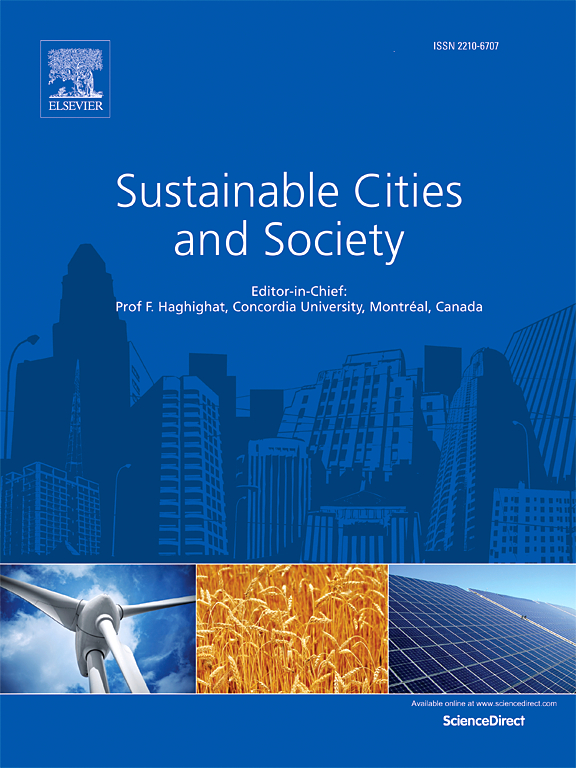Patterns of nighttime surface urban heat island patch in mega urban agglomerations: a case study in the Pearl River Delta, China
IF 10.5
1区 工程技术
Q1 CONSTRUCTION & BUILDING TECHNOLOGY
引用次数: 0
Abstract
Urban heat island (UHI) effects across metropolitan areas poses substantial risks and threats to both ecosystems and residents with intensifying nighttime temperatures, however, the megalopolistic patterns and evolution of nighttime surface UHI (SUHI) remain poorly understood. Using the Pearl River Delta (PRD) in China as a representative mega urban agglomeration, this study employed a combination of geostatistical models and exponential decay model to identify urban heat island patches (UHIP) from 2003 to 2019. The analysis subsequently assessed the SUHI effects and spatial patterns of UHIP, and finally, explored the factors influencing nighttime SUHI intensity (SUHII). The results demonstrated that: (1) a significant clustering pattern of nighttime SUHII was identified, along with an increasing trend in annual summer nighttime SUHII over the study period. (2) Patch expansion categories revealed diverse SUHI evolution modes, with spatial-temporal dynamics characterized using landscape metrics. The SUHII decreased successively across enclave-type, infill-type, and edge-type patches. (3) Socioeconomic factors exhibited a significant positive correlation with SUHII, while environmental and landscape factors displayed spatially dependent impacts both within and beyond the UHIP. These findings highlight the critical importance of incorporating the heterogeneity and temporal dynamics of nighttime SUHI into urban planning strategies to enhance climate adaptation and strengthen urban resilience in mega-agglomerations.
特大城市群夜间地表城市热岛斑块格局——以珠江三角洲为例
随着夜间气温的升高,城市热岛效应给生态系统和居民带来了巨大的风险和威胁,然而,人们对夜间地表热岛效应(SUHI)的大都市分布模式和演变仍知之甚少。以中国珠江三角洲为代表的特大城市群为研究对象,采用地质统计模型和指数衰减模型相结合的方法,对2003 - 2019年中国城市热岛斑块进行了识别。在此基础上,分析了UHIP的SUHI效应和空间格局,并探讨了夜间SUHI强度的影响因素。结果表明:(1)夜间SUHII具有显著的聚类特征,且夏季夜间SUHII在研究期间呈增加趋势;(2)斑块扩展类型呈现出不同的SUHI演化模式,并以景观尺度表征其时空动态特征。在飞地型、填充型和边缘型斑块中,SUHII依次降低。(3)社会经济因素与城市综合指数呈显著正相关,环境和景观因素对城市综合指数的影响表现出空间依赖性。这些发现强调了将夜间SUHI的异质性和时间动态纳入城市规划战略的重要性,以增强超大城市群的气候适应能力和城市韧性。
本文章由计算机程序翻译,如有差异,请以英文原文为准。
求助全文
约1分钟内获得全文
求助全文
来源期刊

Sustainable Cities and Society
Social Sciences-Geography, Planning and Development
CiteScore
22.00
自引率
13.70%
发文量
810
审稿时长
27 days
期刊介绍:
Sustainable Cities and Society (SCS) is an international journal that focuses on fundamental and applied research to promote environmentally sustainable and socially resilient cities. The journal welcomes cross-cutting, multi-disciplinary research in various areas, including:
1. Smart cities and resilient environments;
2. Alternative/clean energy sources, energy distribution, distributed energy generation, and energy demand reduction/management;
3. Monitoring and improving air quality in built environment and cities (e.g., healthy built environment and air quality management);
4. Energy efficient, low/zero carbon, and green buildings/communities;
5. Climate change mitigation and adaptation in urban environments;
6. Green infrastructure and BMPs;
7. Environmental Footprint accounting and management;
8. Urban agriculture and forestry;
9. ICT, smart grid and intelligent infrastructure;
10. Urban design/planning, regulations, legislation, certification, economics, and policy;
11. Social aspects, impacts and resiliency of cities;
12. Behavior monitoring, analysis and change within urban communities;
13. Health monitoring and improvement;
14. Nexus issues related to sustainable cities and societies;
15. Smart city governance;
16. Decision Support Systems for trade-off and uncertainty analysis for improved management of cities and society;
17. Big data, machine learning, and artificial intelligence applications and case studies;
18. Critical infrastructure protection, including security, privacy, forensics, and reliability issues of cyber-physical systems.
19. Water footprint reduction and urban water distribution, harvesting, treatment, reuse and management;
20. Waste reduction and recycling;
21. Wastewater collection, treatment and recycling;
22. Smart, clean and healthy transportation systems and infrastructure;
 求助内容:
求助内容: 应助结果提醒方式:
应助结果提醒方式:


